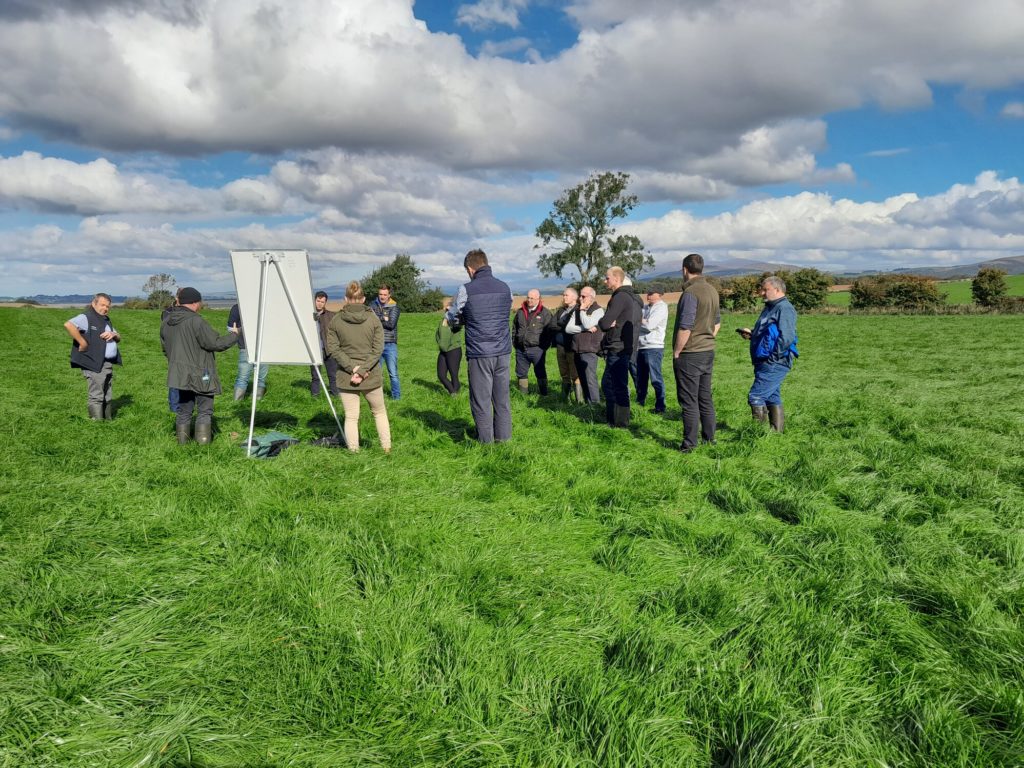Improving Technical Efficiency and Reducing Carbon Emissions
1 November 2022SAC Consulting recently held an open day at Culscadden Farm, Wigtownshire, kindly hosted by Peter & Sarah Simpson who have built up their milking herd to 1000 cows, breeding all their own replacements and selling 750 Angus beef cross calves to Marks and Spencer, annually.
The ‘Chewing the Cud About Dairy Cows and Carbon’ event centred around equipping farmers with knowledge and tools to practically implement on their farm, which would help drive overall productivity but also reduce carbon emissions.
The key take-home messages for the dairy industry from the workshops were:
- Make use of SGRPID funding to carry out soil analysis of your farm and use this information along with slurry analysis to plan your fertiliser and lime strategy for 2023 and beyond. Nitrogen availability drops to 77% when soil pH is at 5.5. With fertiliser prices at record levels, it is essential that pH is at the correct level to make maximum use of inorganic fertiliser.
- Increasing soil organic matter will improve soil health by improving drainage and making soils more resistant to compaction. SRUC research has shown that silage yields can be reduced by as much as 37% in soils compacted by machinery and 19% in those compacted by livestock.
- Increase organic matter by considering adding different species to sward mixes that have longer roots, such as chicory, clover and plantain, as well as using cover crops to add organic material during times where crops aren’t growing.
- Feed conversion efficiency (FCE) calculates the kilos of milk produced from each kilo of dry matter the cow eats and is a useful tool to determine how well cows are utilising forages and feeds. FCE can be influenced by days in milk, frequency of milking and access to feed.
- A target average FCE across a herd would be around 1.35, up to 1.5 for cows in peak lactation. However, it is more useful to measure on a group basis to get an accurate idea of herd performance. Calved heifers are still growing and so will have a lower FCE than mature cows. Late lactation cows are generally fed a less energy dense ration to prevent excessive weight gain and so will have a lower FCE. A high FCE in fresh calved cows can indicate that they are mobilising fat reserves or could be at risk from acidosis if feeding a high concentrate, low forage diet.
- Methane inhibitors could play a role in reducing methane emissions when used alongside other management approaches such as genetics and nutrition but will not be a silver bullet. Methane inhibitors work by disrupting the production of methane in the rumen, and in dairy cows this reduction can be up to 30%. There are products already available on the market that claim to reduce methane emissions, with more to come within the next year. Seaweed has been advocated as a natural methane inhibitor, but much of the research has been carried out with a specific tropical seaweed called Asparagopsis, not found in UK waters and native (UK) seaweeds are much less effective.
- Make use of a smart meter or energy audit to establish your energy usage and consider PV solar panels to reduce electricity usage and costs.
- Genomic testing of heifers allows you to select only the top performing genetics in your herd to breed replacements from, increasing the rate of genetic gain and ensuring your breeding goals are being achieved.
- The 3 Q’s – Quality, Quantity and Quickly for colostrum management are vital to successful calf rearing. Provide a minimum of three litres (or 10% of bodyweight) within the first 2 hours of life of high-quality colostrum. A refractometer or colostrometer are useful, inexpensive tools which every herd should use to ensure the best quality colostrum is being fed to calves. A good quality colostrum will have at least 50g/L IgG, anything less than 20g/L IgG should not be used. In addition, calves can be blood sampled to determine their immunoglobulin levels which is a good indicator of how good your colostrum management is.
- Pasteurising and storing colostrum can help reduce the risk of Johne’s spread and means that colostrum is always available to quickly defrost for new-born calves.
If you would like more information on the event or any of the topics covered, please contact Alison Clark. We acknowledge the University Innovation Fund from the Scottish Funding Council for supporting this event.
alison.clark@sac.co.uk; 01776 502649
Sign up to the FAS newsletter
Receive updates on news, events and publications from Scotland’s Farm Advisory Service

